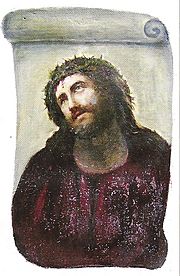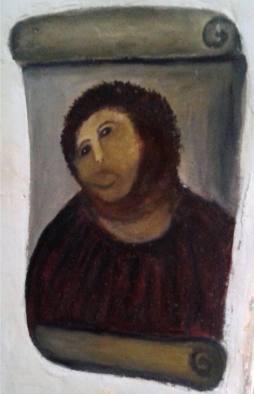Ecce Homo (Martínez and Giménez) facts for kids
Quick facts for kids Ecce Homo |
|
|---|---|

Ecce Homo before the restoration attempt
|
|
| Artist | Elías García Martínez |
| Type | Fresco |
| Dimensions | 50 cm × 40 cm (20 in × 16 in) |
| Location | Sanctuary of Mercy church, Borja, Zaragoza, Spain |
| Owner | Diocese of Tarazona |
The Ecce Homo (which means "Behold the Man" in Latin) is a fresco painting. It is found in the Sanctuary of Mercy church in Borja, Spain. The Spanish painter Elías García Martínez painted it around 1930. It shows Jesus wearing a crown of thorns. The painting's style is typical of traditional Catholic art.
The original painting was not very famous for its art. However, it became very well-known in 2012. This happened after Cecilia Giménez, an amateur artist, tried to restore it. Her attempt changed the painting a lot. It made it look like a monkey. Because of this, people sometimes jokingly call it Ecce Mono (meaning "Behold the Monkey" in Spanish).
Contents
Original Painting's Story
The artist, Elías García Martínez, was a professor at the School of Art of Zaragoza. He gave the painting to the village of Borja. He used to spend his holidays there. He painted it directly on the church wall around 1930. He once said it was "the result of two hours of devotion."
His family still lives in Zaragoza. They knew the painting was in bad condition. His granddaughter even gave money for its restoration. This was just before they found out the painting had been changed.
The Famous Restoration Attempt
At first, officials in Borja thought the painting had been vandalized. But then they found out an elderly church member, Cecilia Giménez, had made the changes. She was 81 years old at the time.
Cecilia told Spanish TV that she started restoring the fresco. She was sad that parts of it were flaking off. This was due to moisture on the church walls. She said she worked in daylight. She also believed the local priest approved. "The priest knew it," she said. "I've never tried to do anything hidden."
Giménez explained that her restoration was not finished. "I left it to dry," she said. "Then I went on holiday for two weeks. I thought I would finish it when I came back." She added, "When I came back, everyone in the world knew about Ecce Homo. How people reacted still hurts me. I wasn’t finished with the restoration."
News of the painting spread globally in August 2012. It quickly became an internet phenomenon. A BBC reporter joked that it looked like "a crayon sketch of a very hairy monkey." People started calling it Ecce Mono. This means 'Behold the Monkey' in Spanish. The event was even compared to a scene in the 1997 movie Bean. Because of all the jokes, the church priest thought about covering the painting.
In 2015, Giménez said, "Everyone here sees what I did differently now." She felt her restoration put Borja on the world map. "So many people have come here," she said. "They tell me more than 130,000 people."
New Artistic Views
Some people started to see the "restored" painting in a new way. A writer for Forbes suggested it showed "one woman's vision of her savior." In September 2012, an art group called Wallpeople displayed many new versions of the image. An organizer said, "Cecilia has created a pop icon."
Later, Spanish actress Assumpta Serna helped make two films about the restoration. One was a documentary called Fresco Fiasco. The other was a movie called Behold the Monkey. Both were shown in the UK in 2016.
A Boost for Tourism
The painting became so popular that the church started charging people to see it. In the year after the restoration, 40,000 people visited. This raised over €50,000 for a local charity.
Cecilia Giménez asked for a share of the money. Her lawyer said she wanted her share to help charities for muscular dystrophy. Her son has this condition.
By 2016, the number of tourists visiting Borja had grown a lot. It went from 6,000 to 57,000 or even 200,000. Visitors spent money at local businesses. They also donated about €50,000 to the church. This money helped hire more church staff. It also funded a home for older people. On March 16, 2016, a special interpretation centre for the artwork opened in Borja.
The €3 tickets bring in over €40,000. This money helps pay €15,000 for two (sometimes five) older people in the town's retirement home. Cecilia Giménez also gets 50% of the money from selling souvenirs.
See also
 In Spanish: Ecce Homo de Borja para niños
In Spanish: Ecce Homo de Borja para niños
- Behold the Man, La Ópera de Cecilia
- Accidental damage of art
- Outsider art


